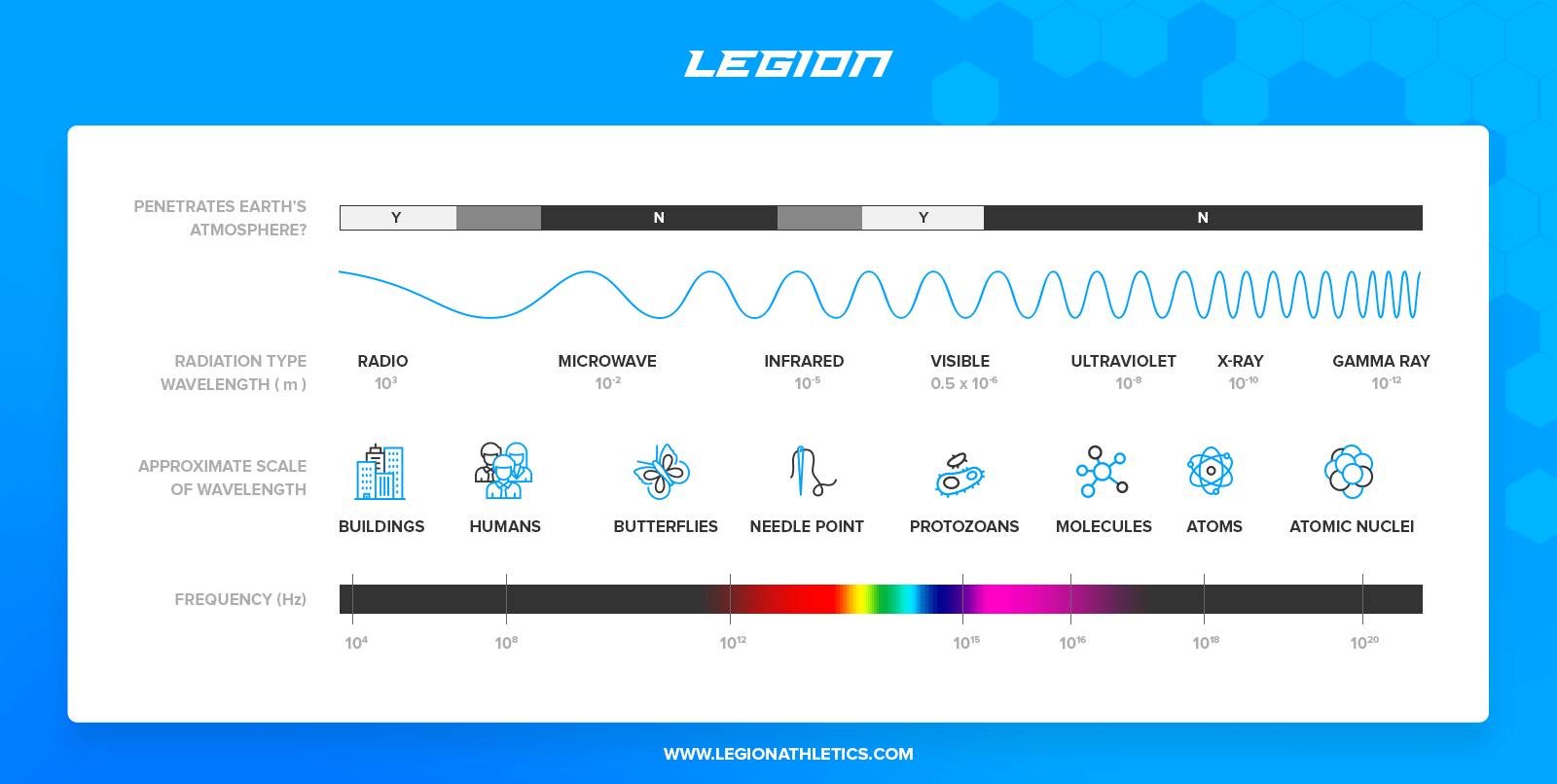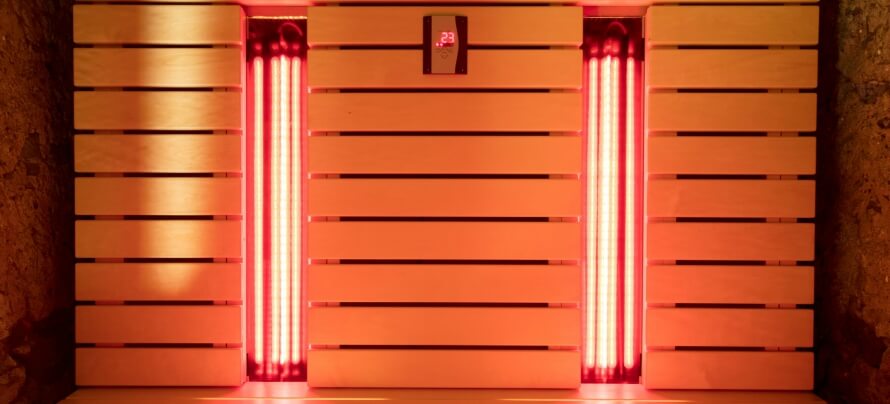Key Takeaways
- Infrared saunas use a (safe) kind of radiation to create heat instead of steam or hot air.
- Infrared sauna won’t help you lose weight, “detox” your body, or prevent disease.
- Infrared sauna may help reduce joint pain and stiffness, improve mood, reduce oxidative stress, and support cardiovascular health.
The health and fitness space is full of gimmicks and gimcracks that promise to help you lose weight, look sexier, and get healthier.
You know, things like…
- Detox teas and “cleanses”
- Starvation (and overly restrictive) diets
- Overhyped nutrition “hacks” (like intermittent fasting and ketogenic dieting)
- Testosterone boosters
- Estrogen blockers
…just to name a few.
The sad truth is if you simply ignored most everything published in most fitness magazines and on most fitness websites and just stuck to the basics of energy balance, macronutrient optimization, compound weightlifting, and progressive overload instead, you’d be far better for it.
You’d be able to gain muscle and lose fat with ease, and you’d be able to do it eating foods and doing workouts that you actually enjoy.
(And if you’d like specific advice about what diet to follow to reach your fitness goals, take the Legion Diet Quiz.)
If you want to speed up the process, though, or optimize other aspects of your health and performance, you can go a bit further.
You can take the right supplements, for example, incorporate mobility work into your exercise regimen, and take simple steps to improve your sleep quality.
And that’s where infrared sauna enters the picture. It isn’t necessary by any means, but depending on whom you listen to, it can be a boon to your overall health and wellbeing.
That’s why this technology has been getting a lot of attention recently, and if you poke around online, you can find doctors, trainers, and “gurus” singing its praises.
According to its proponents, infrared sauna can…
- Detoxify your body
- Enhance circulation
- Promote weight loss
- Lower blood pressure
- Increase immunity
- Relieve aches and pains
- Reduce muscle soreness and speed recovery
- Improve skin health and appearance
- Fight cancer
On the other hand, skeptics and detractors say that most of the hype is humbug, and that these devices are little more than overpriced space heaters.
Who’s right?
Well, when you look to the scientific literature, you discover that the answer is somewhere in the middle.
The long story short is infrared sauna does appear to deliver some health benefits, including reduced joint pain and stiffness and improved blood vessel function, but it can’t do what many people hope: it can’t “detox” your body, help you lose weight faster, boost your immune system, or prevent cancer.
And in this article, we’re going to break it all down.
By the end, you’re going to know what infrared saunas are, how they work, how they can (and can’t) benefit you, how to use them properly, and more.
Let’s get started.
Want to listen to more stuff like this? Check out my podcast!
What Is Infrared Sauna?
An infrared sauna is . . . wait for it . . . a sauna that uses infrared light to create heat instead of steam or hot air (heated by electrical heaters).
Most look something like this . . .

. . . and cost anywhere from 1,000 to 5,000 dollars for the fancier models.
Now, we don’t need to get overly technical, but here’s how an infrared sauna works:
It uses special heating elements to emit infrared light, which is very similar to the light we see but is invisible and creates more heat.
Accordingly, when infrared light penetrates your skin, it increases your internal body temperature, similar to how a traditional dry or wet sauna would.
Is Infrared Sauna Safe?
As infrared light is a form of electromagnetic radiation, many people think the technology might somehow be connected to nuclear bombs, Chernobyl, and cancer.
What most people don’t know, though, is that not all kinds of radiation are bad.
“Radiation” is a broad term that includes any kind of energy that falls on the electromagnetic spectrum. Accordingly, just about everything around you emits some level of radiation, including the lights above your head, the ground underneath your feet, and, of course, the screen you’re staring at right now.
Whether or not radiation is harmful depends on the characteristics of the energy waves and the dose.
For example, large, low-frequency waves tend to be the safest, like the kind emitted from radios (radio waves), whereas small, high-frequency waves like those emitted from the sun can burn your skin.
As you can see in the following chart, some energy waves are bigger than buildings, and others are smaller than atoms:

X-rays, gamma rays, and some ultraviolet rays are the types of radiation that cause cancer, and as a general rule, the further you are away from that end of the spectrum, the less harmful the radiation is to the body.
As you can see above, infrared light is well within the “safe” spectrum, with wavelengths that are larger than the visible light we’re exposed to at all times.
This is why infrared sauna has no known negative side effects, and despite what you might read from the more paranoid people of the Internet, there’s no plausible explanation of how it could harm the body.
What Are the Benefits of Infrared Sauna?
As with most new and exotic health remedies, marketers are quick to claim that infrared sauna can help with just about any problem you might have.
Too fat and lazy to exercise and eat right and too poor for cocaine? Buy my sauna instead! Want whiter teeth, juicier glutes, and harder erections? This model is for you! It’s the new NASA, bitches!
Naturally, then, many people assume the worst and dismiss infrared sauna as “another one of those things” and move on with their lives.
What does science have to say about these fancy light boxes, though?
Well, while the research is currently sparse and there are at least as many questions as answers, there are a number of studies that show that infrared sauna can benefit your health in several ways.
Let’s review some of the more common claims and see how they square with the literature.
Infrared Sauna and Weight Loss
Saunas of any kind can help you lose weight because they make you sweat (thereby reducing water retention).
Remember, though, that losing weight isn’t losing fat.
To do that, the sauna would have to significantly increase your metabolic rate, which it doesn’t.
Instead, it just makes you hot and sweaty, which doesn’t burn calories or indicate you’re burning calories. It just means that your internal temperature is getting too high and your body needs to cool down.
Infrared Sauna and Detoxification
Harmful toxins like manmade chemicals and heavy metals get lodged in our fat cells and can be released through fat burning and then excreted in sweat, so many people believe that infrared saunas can help “detox” your body by making you sweat more.
The problem with this claim is half of the equation is missing: fat burning. While infrared saunas do make you sweat, they don’t trigger fat burning, which means they can’t help your body eliminate toxins.
If you want to know more “detoxification” and what does and doesn’t work, check out this article:
Infrared Sauna and Joint Pain
Here’s the first win for infrared sauna.
Studies do indeed show that infrared sauna can reduce joint pain and stiffness in people with rheumatoid arthritis.
The effects were minor but promising considering the study ran for just 4 weeks and subjects spent only an hour in the sauna each week. (Greater effects may be seen with prolonged use.)
While scientists aren’t sure as to how it does this just yet, they suspect it’s due to anti-inflammatory effects. Furthermore, the improvements persisted after sauna use stopped, which suggests there’s more to the story than “it just feels good to sit in a hot box.”
Infrared Sauna and Cardiovascular Health
Research shows that infrared sauna may improve your blood vessels’ ability to expand and adapt to changes in blood pressure.
Rigid blood vessels are a hallmark of cardiovascular disease, so anything that makes them more flexible is generally good for long-term heart health.
Scientists aren’t sure about the mechanisms in play (and the effects haven’t been replicated yet), but it may be due to an increase in nitric oxide production, which improves blood flow.
Studies also show that infrared sauna can lower your blood pressure, which is also good for your ticker.
Again, we don’t quite know why–it could simply be due to its relaxing effects instead of direct improvements in blood vessel function–but either way, it seems to work.
Research has also shown that infrared sauna can reduce oxidative stress in the body, which may be associated with heart disease and a number of other ailments.
One thing to keep in mind is that these studies were on people who already had heart disease, but given the physiological effects seen, there’s a good chance infrared sauna can help healthy people, too.
Infrared Sauna and Performance
In one study, one group of runners sat in an infrared sauna for 30 minutes after workouts and another group didn’t. After three weeks, the people who used the infrared sauna were able to run 20% longer than those who didn’t.
Now, that sounds nice but when you review the paper, you find the evidence is less than convincing.
First, this study wasn’t blinded, which means the researchers and the subjects knew who was receiving which treatment (and this can skew results).
Second, it included just six people, which is a very small sample size. This is significant because the smaller a sample size is in a study, the greater the odds that the effects were due to random chance and the more the outcomes are skewed by outliers in the data.
Lastly, thanks to the placebo effect, providing just about any type of treatment for just about anything is better than simply doing nothing.
Now, despite those flaws, the infrared sauna did produce a small increase in blood volume, which might improve performance in hot conditions, but that’s as far as I’m willing to go on the subject of infrared sauna and performance without more evidence.
Infrared Sauna and Recovery
A few small studies have shown that infrared saunas can enhance recovery after strength and endurance training by improving neural recovery.
Like the performance research, though, these studies have major flaws–small sample sizes, no blinding, and results that haven’t been consistently replicated–so we just don’t know yet if infrared sauna can actually improve post-workout recovery or not.
Infrared Sauna and Mood
Studies have found that infrared sauna can improve mood and reduce levels of anxiety and depression in people who have chronic fatigue syndrome.
The researchers think the effects were due to a decrease in oxidative stress, but we can’t know for sure because they didn’t actually measure that in this study.
Interestingly, these improvements didn’t occur during the sauna sessions but after, and they increased over time, which suggests they were less likely to be due to the placebo effect.
Now, what does that mean for those of us who aren’t depressed or chronically fatigued?
We don’t know yet because that research hasn’t been done. That said, if the improvements were indeed due to a reduction in oxidative stress, then it’s very possible that infrared sauna can help keep any of us on a more even keel.
Infrared Sauna and Skin Health
According to some people, infrared sauna can improve skin complexion and health, and even reduce lines, wrinkles, and pigmentation.
These effects are allegedly caused by the opening of your pores, which allows dirt, toxins, and other nasties to be carried away in your sweat.
This is false.
Your pores don’t change much in size regardless of temperature, and even if they did, this wouldn’t change your complexion or improve your skin health (if only it were that easy!).
There’s also no evidence that regular or infrared saunas can directly help with this, either.
Infrared Sauna and Cancer
And now we’re really in the woods.
The more militant promoters of infrared sauna say that it can help the immune system better fight cancer, remove carcinogenic chemicals from the body, and even directly kill cancer cells, but there’s absolutely no evidence to support any of these claims.
Infrared Sauna and Illness
A couple studies have found that people who use saunas more often are less likely to get the common cold.
Scientists aren’t sure why, but they think it might have something to do with increased mucous production (which your body uses to eliminate germs).
Keep in mind, though, that these were observational studies, which can help with generating hypothesis and pointing the way for further investigation, but can’t establish causation.
Therefore, based on the current evidence, we can’t say that infrared sauna reduces your risk of the common cold, but we can say that there appears to be an association between sauna use and less sickness.
What’s the Best Way to Use Infrared Sauna?

For infrared sauna to work, the light waves need to penetrate the skin, so anything that gets in the way of that could interfere with the effects.
So, first things first, you want to be mostly naked when in the sauna. The more skin that’s directly exposed to the radiation elements, the better.
Second you should generally avoid wearing makeup, creams, lotions, deodorants, antiperspirants, sunscreen, and other substances that cover the skin.
Finally, it’s usually a good idea to avoid showers and baths before going into an infrared sauna, as moisture on the skin can block the infrared light.
Now, as far as session duration and frequency, there aren’t any cut-and-dry guidelines on what’s best, but most studies have placed subjects in the sauna for 15 minutes to 1 hour per day, and frequency has ranged between every day to once or twice per week.
So, a good rule of thumb would be somewhere in the middle: 30 minutes per day at least every other day, or 3 to 3.5 hours per week.
What’s the Best Type of Infrared Sauna?
There are multiple kinds of infrared light, and some are more beneficial than others.
Specifically, there are three main categories of infrared light based on how large the light waves are (wavelength):
- Near-infrared rays, with a wavelength of 0.75 to 1.5 micrometers (millionths of a meter).
- Medium-infrared rays, with a wavelength of 1.5 to 5.6 micrometers.
- Far-infrared rays, with a wavelength of 5.6 to 1,000 micrometers.
As a general rule, the longer the wavelength is, the more the light will penetrate into the body and affect it.
This is why most high-quality infrared saunas emit far-infrared rays–they’re the most beneficial–and why when shopping for an infrared sauna, you should look specifically for one that emits far-infrared rays between 6 and 20 micrometers in width.
Some sauna marketers brag that their devices also emit near- and medium-infrared rays, but there’s no evidence this offers any additional benefit.
Aside from that, your choice of infrared sauna really comes down to personal preference. I myself have a Clearlight Sanctuary 2 and really like it (and no, I’m not getting paid to say that).
The Bottom Line on Infrared Sauna
Infrared saunas are getting more and more attention these days, and it’s largely deserved.
There’s good evidence that they can…
- Reduce joint pain and stiffness
- Decrease oxidative stress
- Improve mood
There’s weak evidence that they can also…
- Improve symptoms associated with chronic fatigue
- Support cardiovascular health
- Improve performance and recovery
And lastly, there’s no evidence that infrared saunas can…
- Detoxify your body
- Promote weight loss
- Prevent the common cold
- Improve skin health
- Fight cancer
So, on the whole, infrared sauna is at least a mildly beneficial form of health and wellness therapy, but not nearly as powerful as some people claim.
What’s your take on the best and worst nootropics? Have anything else to share? Let me know in the comments below!
Scientific References +
- Beever, R. (2010). The effects of repeated thermal therapy on quality of life in patients with type II diabetes mellitus. Journal of Alternative and Complementary Medicine, 16(6), 677–681. https://doi.org/10.1089/acm.2009.0358
- Yu, S. Y., Chiu, J. H., Yang, S. Der, Hsu, Y. C., Lui, W. Y., & Wu, C. W. (2006). Biological effect of far-infrared therapy on increasing skin microcirculation in rats. Photodermatology Photoimmunology and Photomedicine, 22(2), 78–86. https://doi.org/10.1111/j.1600-0781.2006.00208.x
- Fernández-Cuevas, I., Bouzas Marins, J. C., Arnáiz Lastras, J., Gómez Carmona, P. M., Piñonosa Cano, S., García-Concepción, M. Á., & Sillero-Quintana, M. (2015). Classification of factors influencing the use of infrared thermography in humans: A review. In Infrared Physics and Technology (Vol. 71, pp. 28–55). Elsevier B.V. https://doi.org/10.1016/j.infrared.2015.02.007
- Ernst, E., Pecho, E., Wirz, P., & Saradeth, T. (1990). Regular sauna bathing and the incidence of common colds. Annals of Medicine, 22(4), 225–227. https://doi.org/10.3109/07853899009148930
- Soejima, Y., Munemoto, T., Masuda, A., Uwatoko, Y., Miyata, M., & Tei, C. (2015). Effects of Waon therapy on chronic fatigue syndrome: A pilot study. Internal Medicine, 54(3), 333–338. https://doi.org/10.2169/internalmedicine.54.3042
- Noponen, P. V., Hakkinen, K., & Mero, A. A. (2015). Effects of Far Infrared Heat on Recovery in Power Athletes. Journal of Athletic Enhancement, 04(04). https://doi.org/10.4172/2324-9080.1000202
- Mero, A., Tornberg, J., Mäntykoski, M., & Puurtinen, R. (2015). Effects of far-infrared sauna bathing on recovery from strength and endurance training sessions in men. SpringerPlus, 4(1), 1–7. https://doi.org/10.1186/s40064-015-1093-5
- Akerman, A. P., Tipton, M., Minson, C. T., & Cotter, J. D. (2016). Heat stress and dehydration in adapting for performance: Good, bad, both, or neither? In Temperature (Vol. 3, Issue 3, pp. 412–436). Routledge. https://doi.org/10.1080/23328940.2016.1216255
- Hróbjartsson, A., & Gøtzsche, P. C. (2010). Placebo interventions for all clinical conditions. In Cochrane Database of Systematic Reviews (Vol. 2010, Issue 1). John Wiley and Sons Ltd. https://doi.org/10.1002/14651858.CD003974.pub3
- Karanicolas, P. J., Farrokhyar, F., & Bhandari, M. (2010). Blinding: Who, what, when, why, how? Canadian Journal of Surgery, 53(5), 345–348. https://www.ncbi.nlm.nih.gov/pmc/articles/PMC2947122/
- Scoon, G. S. M., Hopkins, W. G., Mayhew, S., & Cotter, J. D. (2007). Effect of post-exercise sauna bathing on the endurance performance of competitive male runners. Journal of Science and Medicine in Sport, 10(4), 259–262. https://doi.org/10.1016/j.jsams.2006.06.009
- Csányi, G., & Miller, F. J. (2014). Oxidative stress in cardiovascular disease. In International Journal of Molecular Sciences (Vol. 15, Issue 4, pp. 6002–6008). MDPI AG. https://doi.org/10.3390/ijms15046002
- Fujita, S., Ikeda, Y., Miyata, M., Shinsato, T., Kubozono, T., Kuwahata, S., Hamada, N., Miyauchi, T., Yamaguchi, T., Torii, H., Hamasaki, S., & Tei, C. (2011). Effect of Waon therapy on oxidative stress in chronic heart failure. Circulation Journal, 75(2), 348–356. https://doi.org/10.1253/circj.CJ-10-0630
- Janssen, C. W., Lowry, C. A., Mehl, M. R., Allen, J. J. B., Kelly, K. L., Gartner, D. E., Medrano, A., Begay, T. K., Rentscher, K., White, J. J., Fridman, A., Roberts, L. J., Robbins, M. L., Hanusch, K. U., Cole, S. P., & Raison, C. L. (2016). Whole-body hyperthermia for the treatment of major depressive disorder: A randomized clinical trial. JAMA Psychiatry, 73(8), 789–795. https://doi.org/10.1001/jamapsychiatry.2016.1031
- Umehara, M., Yamaguchi, A., Itakura, S., Suenaga, M., Sakaki, Y., Nakashiki, K., Miyata, M., & Tei, C. (2008). Repeated Waon therapy improves pulmonary hypertension during exercise in patients with severe chronic obstructive pulmonary disease. Journal of Cardiology, 51(2), 106–113. https://doi.org/10.1016/j.jjcc.2008.01.004
- Go, Y. M., Park, H., Maland, M. C., & Jo, H. (1999). In vitro system to study role of blood flow on nitric oxide production and cell signaling in endothelial cells. Methods in Enzymology, 301, 513–522. https://doi.org/10.1016/S0076-6879(99)01114-3
- Watanabe, H. (2000). Endothelial dysfunction and cardiovascular diseases. Japanese Pharmacology and Therapeutics, 28(6), 441–443. https://doi.org/10.5339/gcsp.2014.43
- Shui, S., Wang, X., Chiang, J. Y., & Zheng, L. (2015). Far-infrared therapy for cardiovascular, autoimmune, and other chronic health problems: A systematic review. In Experimental Biology and Medicine (Vol. 240, Issue 10, pp. 1257–1265). SAGE Publications Inc. https://doi.org/10.1177/1535370215573391
- Oosterveld, F. G. J., Rasker, J. J., Floors, M., Landkroon, R., van Rennes, B., Zwijnenberg, J., Laar, M. A. F. J., & Koel, G. J. (2009). Infrared sauna in patients with rheumatoid arthritis and ankylosing spondylitis. Clinical Rheumatology, 28(1), 29–34. https://doi.org/10.1007/s10067-008-0977-y
- Sears, M. E., Kerr, K. J., & Bray, R. I. (2012). Arsenic, cadmium, lead, and mercury in sweat: A systematic review. In Journal of Environmental and Public Health (Vol. 2012). Hindawi Publishing Corporation. https://doi.org/10.1155/2012/184745
- La Merrill, M., Emond, C., Kim, M. J., Antignac, J. P., Le Bizec, B., Clément, K., Birnbaum, L. S., & Barouki, R. (2013). Toxicological function of adipose tissue: Focus on persistent organic pollutants. In Environmental Health Perspectives (Vol. 121, Issue 2, pp. 162–169). National Institute of Environmental Health Sciences. https://doi.org/10.1289/ehp.1205485
- Vatansever, F., & Hamblin, M. R. (2012). Far infrared radiation (FIR): Its biological effects and medical applications. In Photonics and Lasers in Medicine (Vol. 1, Issue 4, pp. 255–266). Walter de Gruyter GmbH. https://doi.org/10.1515/plm-2012-0034
- Kellerer, A. M. (1999). The effects of neutrons in Hiroshima. Implications for the risk estimates. Comptes Rendus de l’Academie Des Sciences - Serie III, 322(2–3), 229–237. https://doi.org/10.1016/S0764-4469(99)80048-1
- Cardis, E., & Hatch, M. (2011). The Chernobyl Accident - An Epidemiological Perspective. Clinical Oncology, 23(4), 251–260. https://doi.org/10.1016/j.clon.2011.01.510
- Okubo, T. (2012). Long-term epidemiological studies of atomic bomb survivors in Hiroshima and Nagasaki: Study populations, dosimetry and summary of health effects. Radiation Protection Dosimetry, 151(4), 671–673. https://doi.org/10.1093/rpd/ncs179











